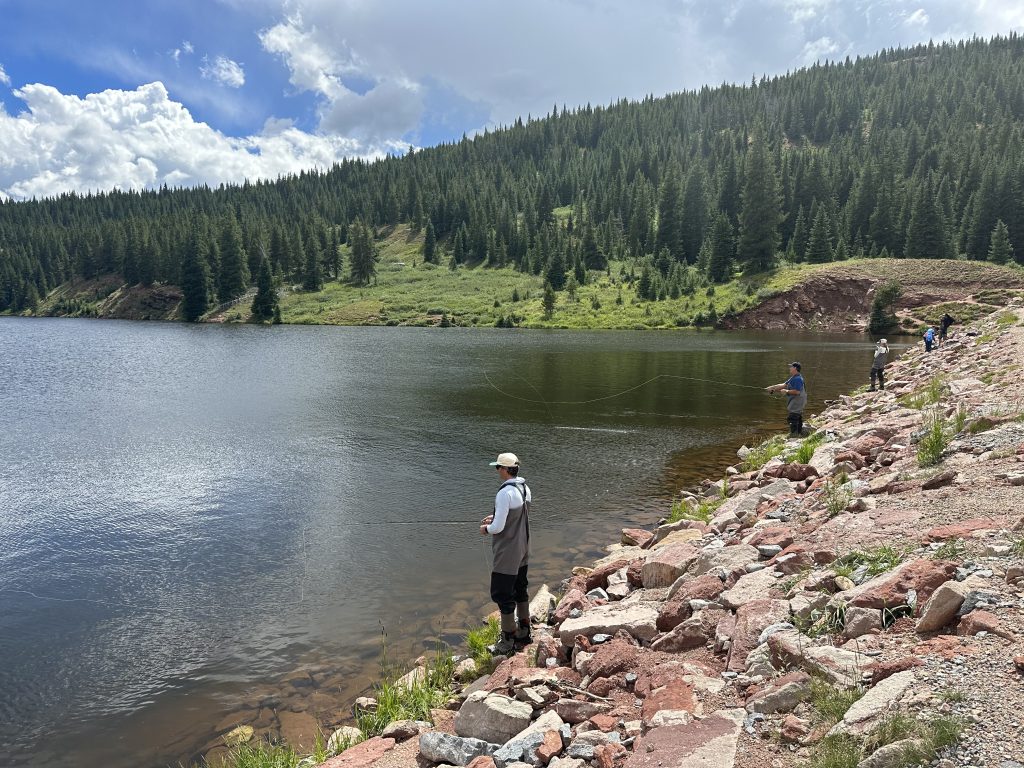Salomone: Fishing nymphs in stillwaters.
Treasures await those willing to expand their fly-fishing experience

Michael Salomone/Courtesy photo
The river’s waking up, pushing muddy color and rising. Fly anglers looking for alternatives to the less-than-perfect conditions or in need of safer locations for young anglers are appearing around stillwaters. An enjoyable alternative to wading the river, these ponds, lakes and reservoirs hold secret treasures. Working a nymph in stillwaters is the key to deciphering the code and uncovering the trout treasures we all seek.
Setting up for nymphing on still waters should not cause angst in anglers. Experimentation with different depths is key. Plan on altering your rig throughout the day to achieve the best possible presentation. Fly anglers who set their rig up in the parking lot and refuse to change create a narrow chance for success.
Rods for the job cover a wide variety, but this is an opportunity to break out the old school gear. Old school gear works. Flex some fiberglass and listen to the ticking of a click and pawl Pflueger Medalist.

Leaders are key to achieving specific depths, presentations and effectiveness. Rarely are leaders too long for stillwater applications. Most leaders are too short, unable to reach effective depth without detrimental drag. Long leaders are more streamlined and cut through the water column with efficiency. Ever seen a 12-foot or 15-foot leader on the shelf and thought, “what for?” Spring creeks are one place for long leaders, but the necessity to achieve depth in stillwaters places increased emphasis on leader length.
Deep-water nymphing in our local stillwaters can be achieved with a 9-foot leader. The addition of tippet increases depth and maintains durability. Weights need to be added to achieve proper depths. Experimentation is key to finding an effective depth range and to determine how much weight is necessary to achieve that depth.

Support Local Journalism
Heavy nymph rigs are a burden to cast with any semblance of fluid motion. Roll casting keeps flies in proper position and clear of angler interference. Overweighted nymphs, large indicators and pinched on lead create an unattractive delivery challenge for some anglers. But when it comes to stillwater nymphing, deep down works.
Rising nymphs are key once a hatch begins to gain momentum. The addition of hackle feathers to nymph flies creates the illusion of swimming. Stagnant, tightly-bound nymphs are necessary to any fly box but with the addition of soft hackles the same fly takes on a whole new profile and position in the water column. Subtle movement sells the ascending nymph.
Combination presentations such as dry dropper rigs cover the upper water column where active trout are feeding. Dry droppers gives fish two options to taunt their psyche. Fishing a large Parawulf with a soft hackle dropper or emerger fly in the Black Lakes on Vail Pass garners strikes on both bugs.
Timing during the hatch is key in terms of when to use each rig. As summer progresses the timing possesses a broader frame, but springtime requires observation and awareness of minute changes occurring in a shorter amount of time.
Scuds are one of the most important stillwater flies in the box. Soft hackles, zebra nymphs and wooly buggers all deserve a position, too. Damselflies will soon be in the air; that means damsel nymphs are present in the stillwaters now. Dangling two nymphs off your tippet to form a tandem nymph rig covers multiple bugs at once. Fly anglers who find pleasure in stillwaters benefit from a designated fly box.
An obscure fly most anglers overlook is the water boatman. Short, erratic strips with a water boatman elicits violent strikes from down deep near the weed growth. Similar presentations with scud flies near the underwater weed line grabs the attention of any hungry, deep water denizen.

Squirmy worms work wonders fished deep and under a strike indicator. The presence of panfish along with stocked rainbow trout in Gypsum Ponds State Wildlife Area places additional promise on a worm rig. A common San Juan worm works, too, but the feel of the squirmy worm material is more lifelike. This results in fish committing to the fly rather than nibbling and pecking at the fly.
The pace of the river assists many anglers in fishing nymphs in moving water. Translating your knowledge of free flowing nymph fishing to stillwaters opens up new venues for increased fly fishing enjoyment. Breaking out old but still functional gear brings sentimental smiles to faces.
Broaden your fly-fishing experience with a little stillwater nymphing. Who knows what treasures you’ll catch.










